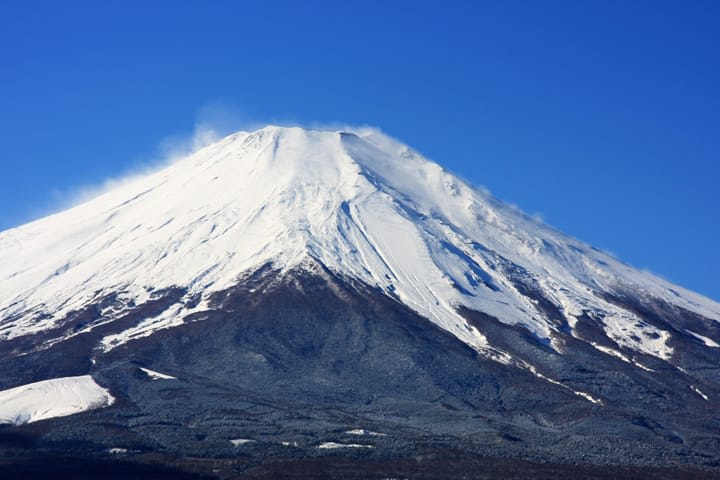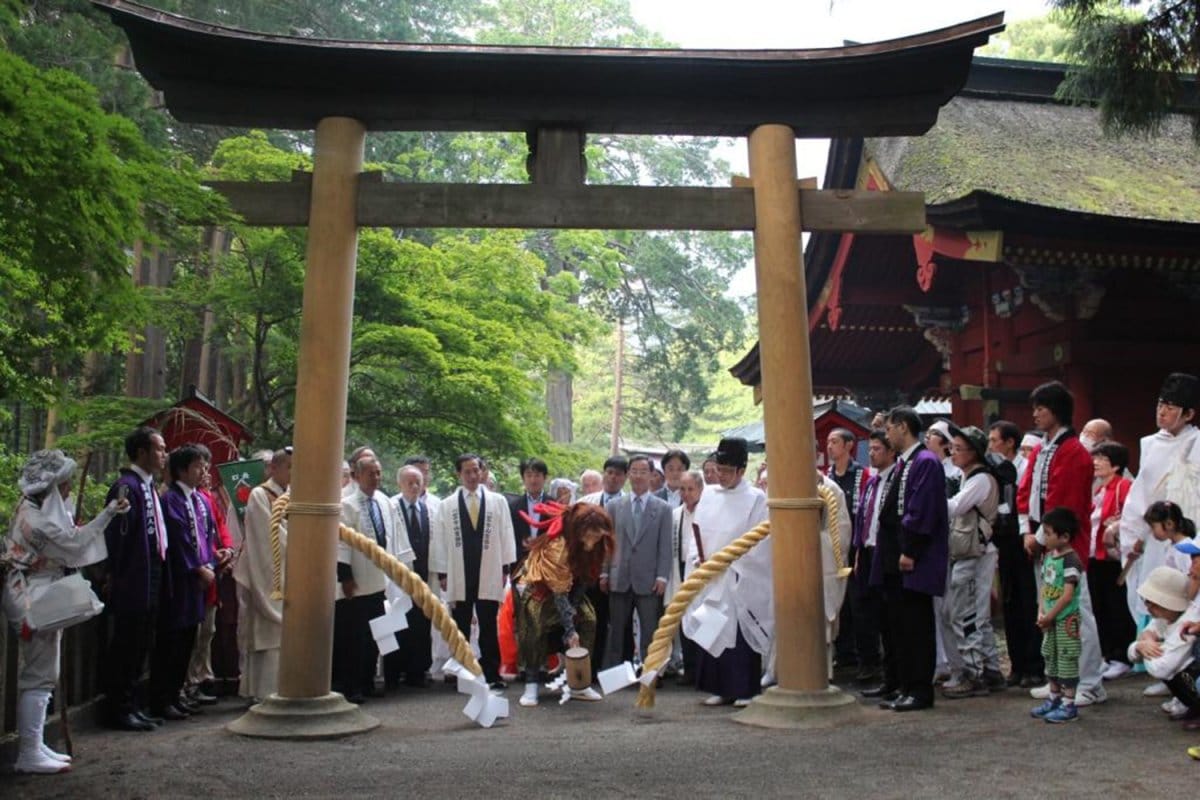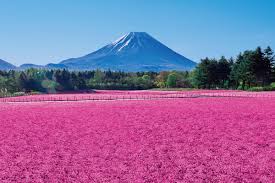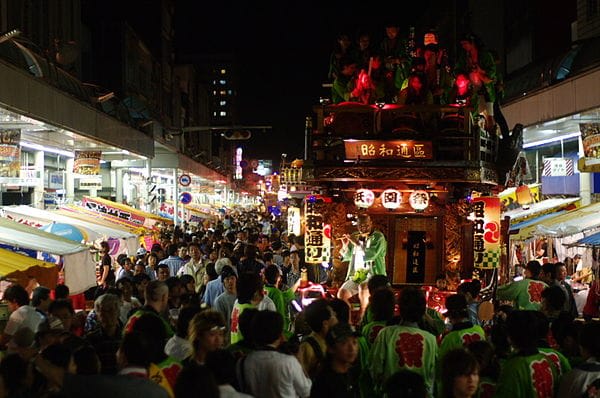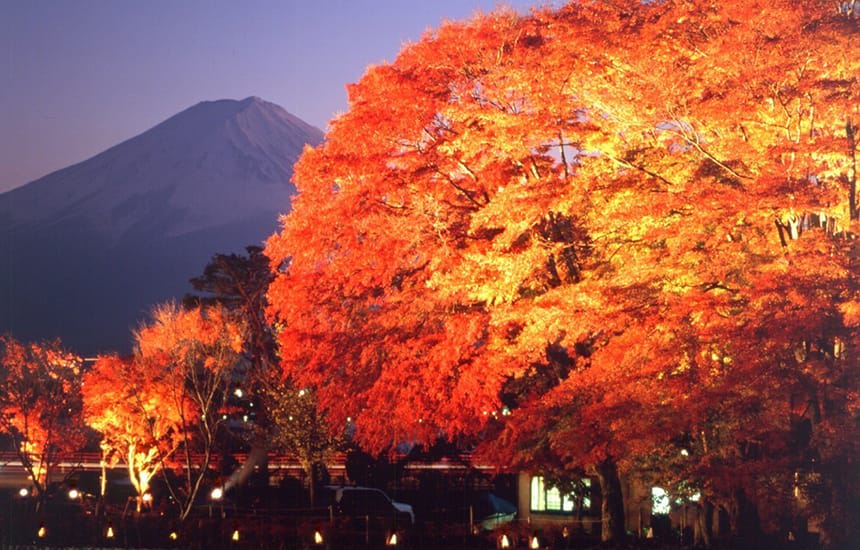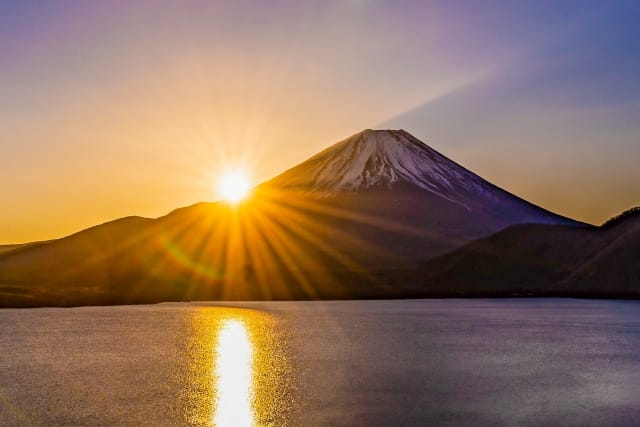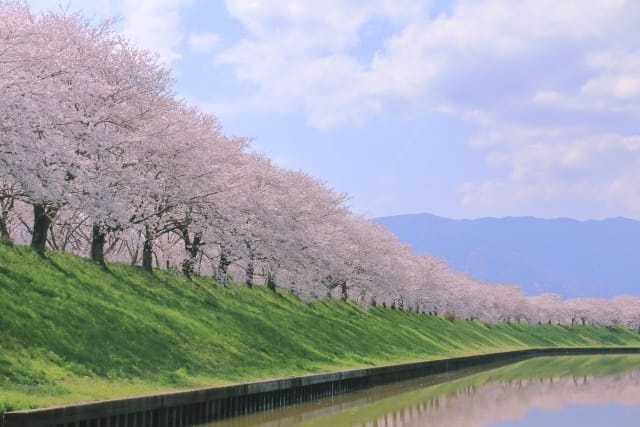Mt. Fuji Weather Guide 2026 w/ mt fuji visibility forecast: Seasonal Climate Insights, Best Viewing Times & Snow Prediction
It's been long time since I started writing articles for Magical Trip Media, and I've written over 400 articles. With the transition into 2026, I've decided to update my articles based on both my experience and the latest information.
One reason for this update is the growing interest in tours around Mount Fuji. Since the Mount Fuji area consists of several regions, it can be challenging for tourists to plan their own itineraries.
Magical Trip has finally launched private tours that take visitors around tourist spots by car with guides who know the Mount Fuji area inside and out.

Launched in December, Magical Trip's "Mt. Fuji Full-day Nature Guided Tour with a Private Chartered Car & Guide" is a flexible tour that adapts the itinerary based on guests' interests.
The tour has already received great reviews from many guests who enjoyed the magnificent nature around Mount Fuji and its excellent local cuisine.
Since you can efficiently visit all the must-see spots around Mount Fuji in one day, I highly recommend taking this tour during your Tokyo trip.
Check out the video to get a clear picture of the tour details
Introduction
Mt. Fuji, a UNESCO World Heritage site, has been beloved as Japan's symbol since ancient times.
Beyond its solitary beauty, it has been both feared and revered as a divine mountain due to its repeated volcanic eruptions throughout history.
Since the 12th century, climbing Mt. Fuji has become popularized, and even today, many climbers visit during summer. While Mt. Fuji is a destination everyone dreams of conquering, as Japan's highest mountain, it presents natural challenges more severe than one might imagine.
Today, we'll thoroughly examine Mt. Fuji's climate and weather characteristics, and share essential rules for a safe and enjoyable trip.
Table of Content
・The Climate Around Mt. Fuji Varies Significantly with Altitude
Climate at 1,000m/Climate Around Fujinomiyaguchi 5th Station (2,400m)/Climate Near Mt. Fuji's Summit (3,776m)
・Climate During Climbing Season (Early July - Mid-September)
Climate and Recommended Clothing during Climbing Season
・Climate Before Climbing Season (Spring to Summer)
Climate and Recommended Clothing from Spring to Summer
・Climate After Climbing Season (Autumn to Winter)
Climate and Recommended Clothing from Autumn to Winter
・Winter (December - March) Climate
Climate and Recommended Clothing during Winter
・[Seasonal] Recommended Events with Highlights
Particularly noteworthy events around Mt. Fuji by season
・Summery
Article Summary and Secret Tours Offered by Magical Trip
The Climate Around Mt. Fuji Varies Significantly with Altitude
Mt. Fuji, Japan's highest mountain, is truly the nation's symbol.
The weather and temperature between the mountain base and the summit (above 3,000m) are completely different.
At the summit, with no surrounding obstacles, extremely strong winds blow frequently - comparable to typhoon-force winds. As evidenced by year-round snow, even during midsummer heat waves at ground level, the summit experiences winter-like conditions. This is why even in summer, there's a risk of fatal hypothermia.
To safely enjoy Mt. Fuji tourism, it's crucial to consider the altitude of areas you'll visit and prepare appropriate equipment.
Climate at 1,000m Altitude (Around Lake Kawaguchi)

Mountain temperatures decrease proportionally with altitude. Temperature drops approximately 0.6°C per 100m elevation gain. Remember that at 1,000m elevation, there's about a 6°C difference compared to ground level.
The lower mountain areas around 1,000m can be enjoyed even in midwinter if there's no snow. However, UV radiation is 10-12% stronger than at ground level, so year-round UV protection is essential.
[Tourist Spots at 1,000m]
- Fuji Five Lakes (Lake Yamanakako, Lake Kawaguchiko, Lake Saiko, Lake Shojiko, Lake Motosuko *800m-1000m)
- Asagiri Highland
- Fuji-Q Highland
- Mt. Fuji Panoramic Ropeway and Observatory
- Kitaguchi Hongu Fuji Sengen Shrine
- Suwa Forest Nature Park
- Michi-no-Eki Fujiyoshida
Climate Around Fujinomiyaguchi 5th Station (2,400m)
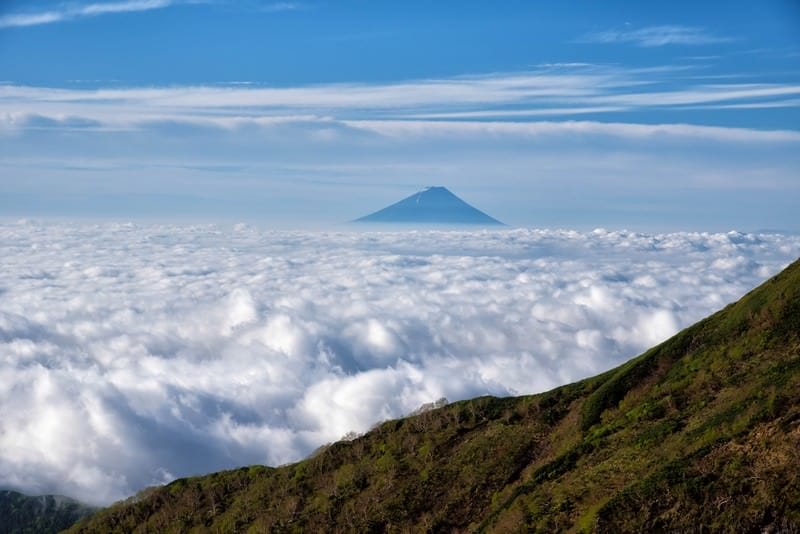
Currently, Mt. Fuji has four climbing routes, with Fujinomiyaguchi being the highest starting point. The 5th station marks the beginning of climbing routes and maintains cool temperatures even in summer.
Note: "Go" (station) represents climbing difficulty levels, dividing the trail from base to summit into 10 sections.
Even during climbing season in summer, temperatures at the 5th station range from 15-16°C. As altitude increases, wind effects become more pronounced, making the perceived temperature even lower (approximately -1°C per 1m/s wind speed).
Climate Near Mt. Fuji's Summit (3,776m)
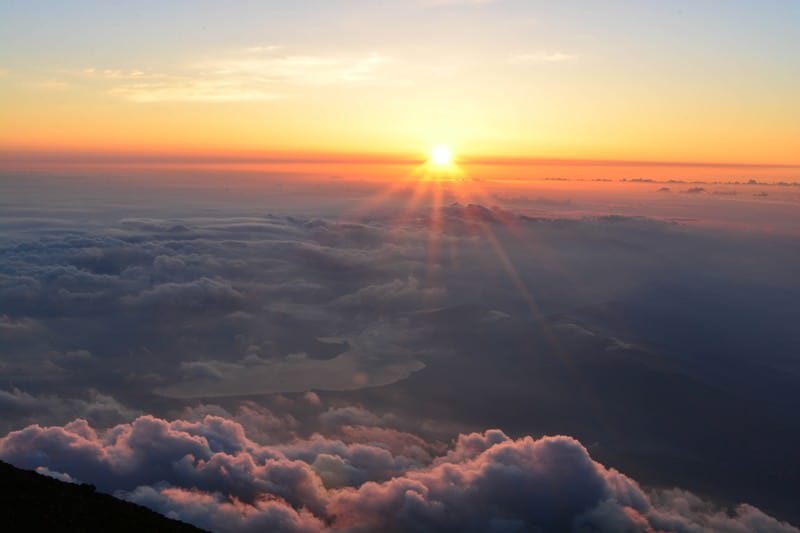
Mt. Fuji's annual average temperature is very low at -7.1°C, reaching only 6-7°C even in August. The temperature difference from ground level can approach 20°C. Nights are even colder, with winter-like temperatures even in summer.
While many tourists visit for sunrise viewing, temperatures can drop to near 0°C before dawn, requiring precautions against hypothermia.
Additionally, Mt. Fuji is famous for its rapidly changing weather conditions. Climbers should never push themselves too hard and always prioritize safety.
Optimal Conditions for Viewing Mt. Fuji
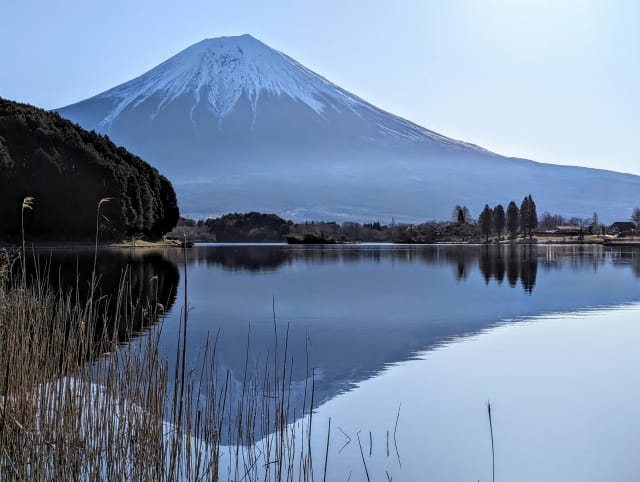
The most important condition for seeing Mt. Fuji clearly is having clear, sunny weather. While Mt. Fuji can be visible on cloudy days, clouds often obscure the mountain, making it difficult to see its complete form and crisp appearance. Understanding Mt. Fuji climate and weather patterns is essential for planning the perfect viewing experience.
Whether the air is clear is also a crucial condition. The amount of water vapor and dust particles in the air affects how clearly Mt. Fuji appears or how hazy it looks. The Mt. Fuji weather conditions vary significantly with each season, and the movement of air currents also influences how well the mountain can be seen.
Time of day is another important factor. Due to ocean currents and topographical relationships, mornings are typically the best time to see beautiful, clear views of Mt. Fuji because there are fewer clouds. The Mt. Fuji climate conditions during early hours often provide the most spectacular viewing opportunities.
Mt. Fuji's visibility changes constantly depending on the season, daily weather conditions, and even the time of day. Before heading out, we recommend checking the weather and Mt. Fuji's current appearance using live cameras at seven major surrounding viewing spots.
https://www.yamanashi-kankou.jp/fujisanwatcher/live/index.html
Key Viewing Locations
Lake Yamanakako
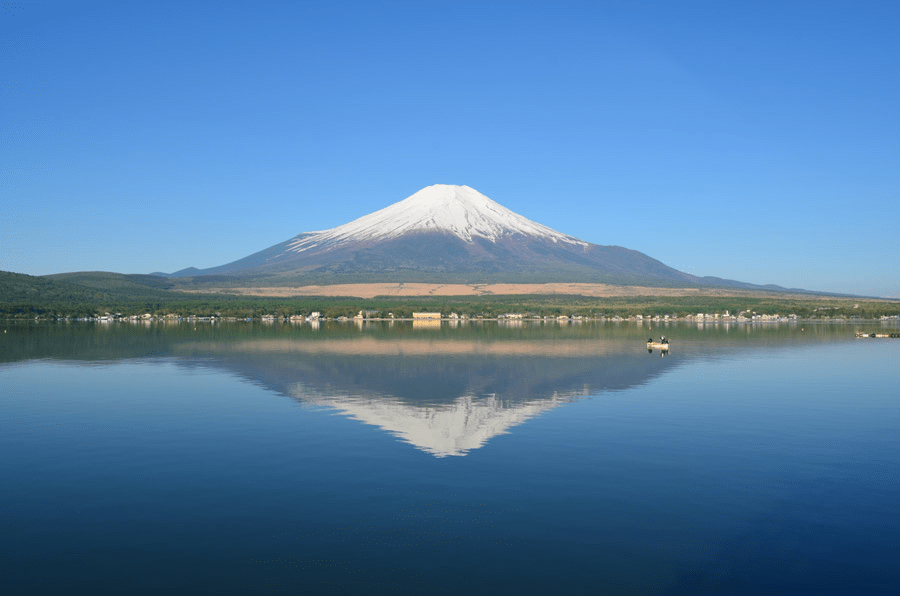
One of the Fuji Five Lakes and the closest lake to Mt. Fuji. Located on the eastern side of Mt. Fuji at an elevation of nearly 1,000 meters, offering beautiful and magnificent views of the mountain.
Access Information: 90 minutes by car from Tokyo
Fujigane
An area located in the highland region spreading across the western foothills of Mt. Fuji. Being a dairy farming area, visitors can enjoy views of the massive Mt. Fuji rising behind vast grasslands.
Access Information: 60 minutes by bus from Kawaguchiko Station
Lake Shojiko
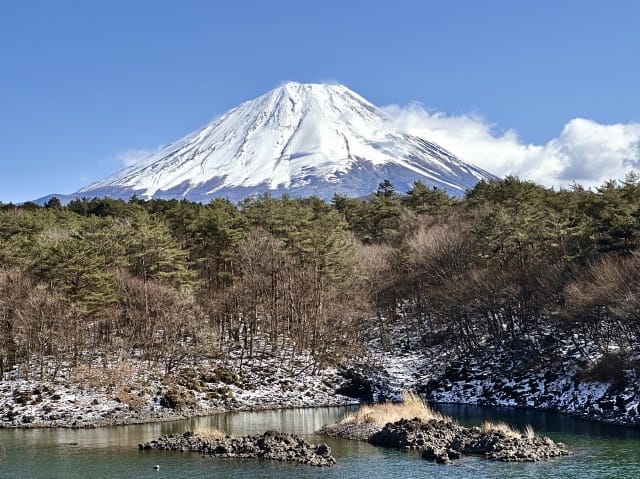
A small lake located northwest of Mt. Fuji, one of the Fuji Five Lakes. Visitors can enjoy boating and fishing while viewing Mt. Fuji. The famous scenery of Mt. Omuro (a small mountain in the foreground) together with Mt. Fuji is also well-known.
Access Information: 40 minutes by bus from Kawaguchiko Station
Lake Motosuko (View as 1,000 Yen Note Mt Fuji)
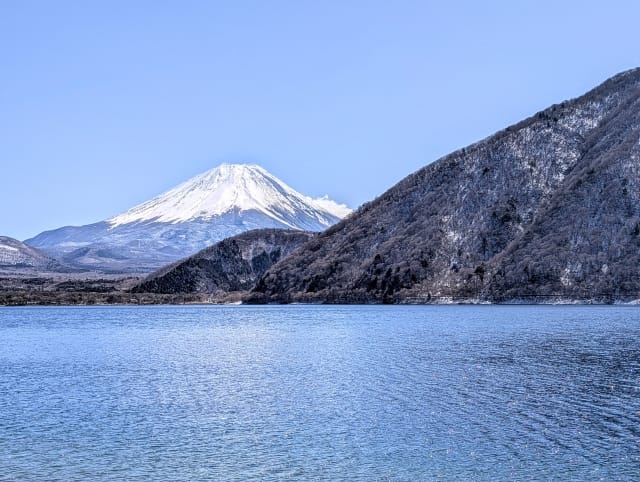
Lake Motosuko is a quiet lake with high transparency located northwest of Mt. Fuji. The beautiful view of Mt. Fuji from Lake Motosuko is featured on Japan's former 1,000 yen banknote and current 5,000 yen banknote.
Access Information: 60 minutes by bus from Kawaguchiko Station
Fujiyoshida City
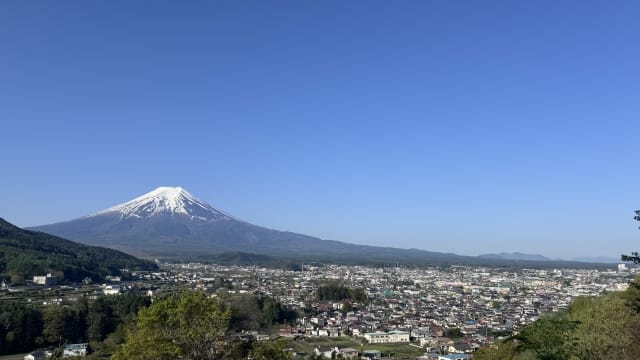
A city in Yamanashi Prefecture spreading across the northwestern foothills of Mt. Fuji. The area features the Fujiyoshida entrance for Mt. Fuji climbing and Arakura Sengen Shrine, where visitors can see the traditional five-storied pagoda together with Mt. Fuji.
Access Information: 120 minutes by car from Tokyo, 180 minutes by train
Lake Kawaguchiko

The second largest of the Fuji Five Lakes, located north of Mt. Fuji. With numerous tourist facilities and shops, visitors can enjoy activities while viewing Mt. Fuji. The autumn foliage and cherry blossoms along the lakeshore are also famous.
Access Information: 7 minutes by bus and on foot from Kawaguchiko Station
Shindo Touge
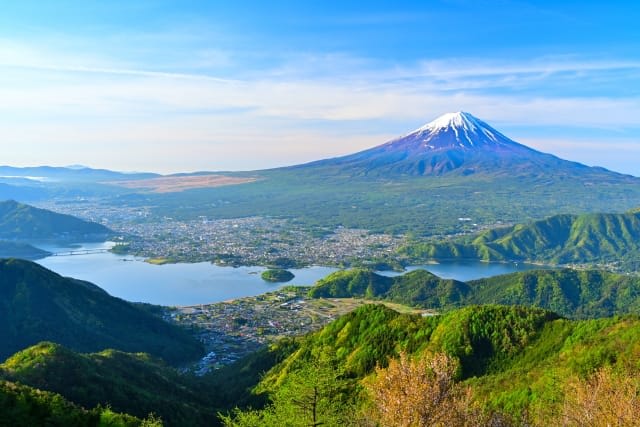
A mountain pass road located north of Mt. Fuji. Visitors can view Mt. Fuji diagonally from the foothills. At an elevation of 1,600 meters, there is an observation facility called "Fujiyama Twin Terrace."
Access Information: 40 minutes by taxi from Isawa Onsen Station, 10 minutes by shuttle bus
Mt. Fuji Climate and Seasonal Appearance: A Detailed Guide by the Author
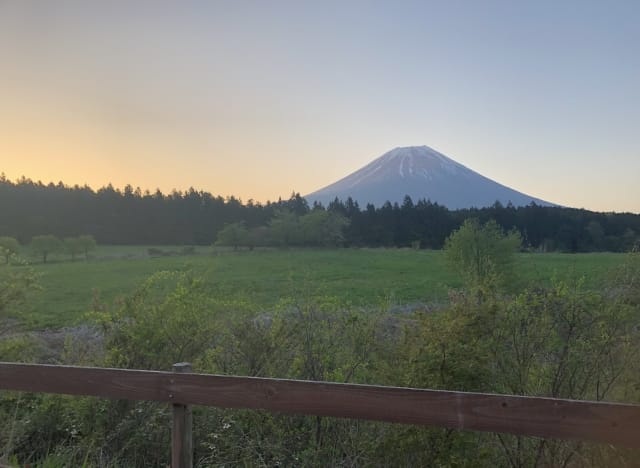
The Mt. Fuji climate varies dramatically by season. Even within the same season, the weather changes subtly month by month, and the amount of snow and mountain colors visible from the base constantly transform.
For example, snow can be observed accumulating on Mt. Fuji annually from October through early June. Snow gradually begins accumulating on the summit from October, and by February, the entire mountain can be seen covered in snow.
Here, we will provide detailed explanations of each season's and month's climate characteristics, Mt. Fuji's appearance, snow amounts, and the surrounding natural scenery.
Climate Features of Climbing Season (June, July, and August)
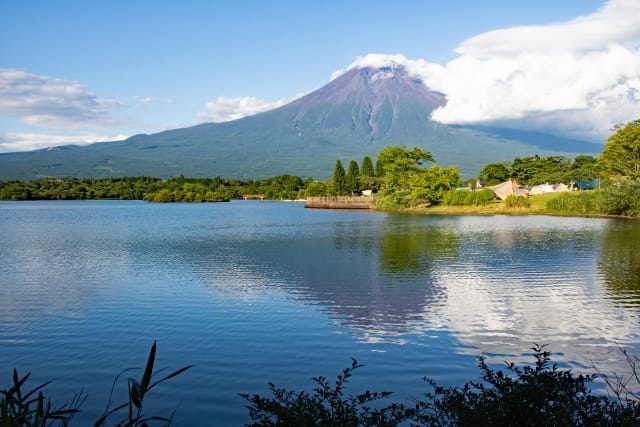
Every year from June to August is the climbing season when many climbers gather at Mt. Fuji.
In June, Mt. Fuji's snow begins to melt. Since June in Japan is the rainy season, the abundant rainfall rapidly melts the snow. Due to rain and clouds, Mt. Fuji is often invisible from the base, but during breaks in the rain, you can observe Mt. Fuji with decreasing snow day by day.
In July, Mt. Fuji shows exposed soil near the summit above 3,000 meters, while areas below are enveloped in green. However, even in summer, the summit drops to around 0°C at night, and snow may fall. While thin streaks of snow are visible from the base, accumulation sufficient to cover the mountain in snow is rare.
During August, the peak climbing period, Mt. Fuji is often shrouded in clouds when viewed from the base. The high moisture content in the air also makes it appear somewhat hazy. On clear days with low humidity, you can enjoy views of Mt. Fuji surrounded by summer's blue skies and refreshing greenery.
When Does Mt. Fuji Begin to Be Enveloped in Fresh Greenery?
In the base areas, fresh greenery can be seen as early as late April to May. In May, you can enjoy refreshing scenes of trees with light green foliage alongside Mt. Fuji.
After May and into June, the mountains surrounding Mt. Fuji and the entire base forest are enveloped in brilliant green. Additionally, the Mt. Fuji area is famous for tea production, and from May to June, you can view beautiful green tea fields together with Mt. Fuji.
In July around Mt. Fuji's base, you can enjoy summer's refreshing greenery and flowers in a climate cooler than Tokyo. At Flower City Park near Lake Yamanaka, where you can view flower fields with Mt. Fuji, light purple lavender fields peak in July, while sunflower fields are at their best in August.
Climate Features of Autumn (September, October, and November)
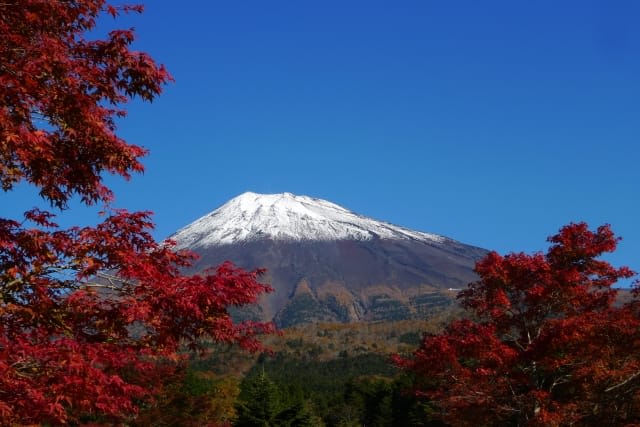
In September, Mt. Fuji typically shows exposed soil when viewed from the base. While it's still climbing season until early September with little snowfall at the summit, temperatures drop significantly both at the summit and base from mid-September onward.
October marks the beginning of clear air, making it a season for beautiful Mt. Fuji viewing. Autumn foliage begins in surrounding areas, and Mt. Fuji starts to be capped with snow. This is the season when you can capture beautiful photographs framing both autumn foliage and snow-capped Mt. Fuji in the same shot, attracting many photographers to the Mt. Fuji area.
October also tends to produce beautiful clouds in morning and evening skies, offering a season to enjoy dramatic sky scenes together with Mt. Fuji.
In November, moisture and particles in the air decrease further, and the air becomes clearer, allowing for sharp, distinct views of Mt. Fuji.
When Does Surrounding Autumn Foliage Begin to Color?
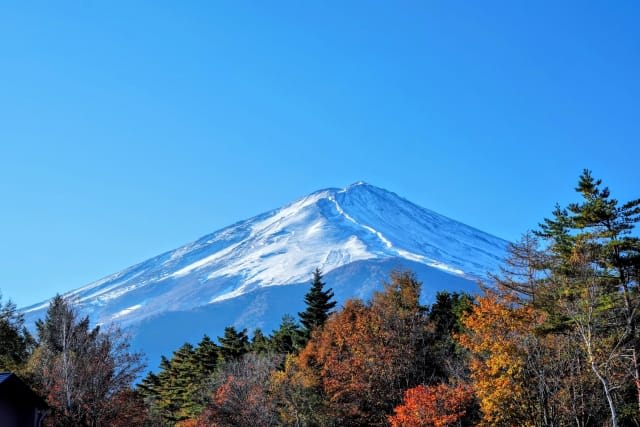
In early October, trees at Mt. Fuji 5th Station, located at 2,400 meters elevation, begin to change color. At the base, autumn foliage begins around mid-October, with the most vibrant autumn scenery visible from late October to early November.
Mt. Fuji viewed together with vibrantly colored surrounding autumn foliage creates a breathtakingly gorgeous spectacle. Particularly famous is the autumn foliage visible at the shores of Lake Kawaguchi, one of the Fuji Five Lakes. Hundreds of maple and other trees turn colors, and the "Fujikawaguchiko Autumn Leaves Festival" is held, drawing many visitors.
Illumination is also conducted at night. The fantastical autumn foliage and Mt. Fuji softly illuminated at night create a must-see view. Additionally, I recommend viewing Mt. Fuji together with golden Japanese silver grass—a very elegant, uniquely autumn spectacular view.
When Does Snow Begin Accumulating on Mt. Fuji?
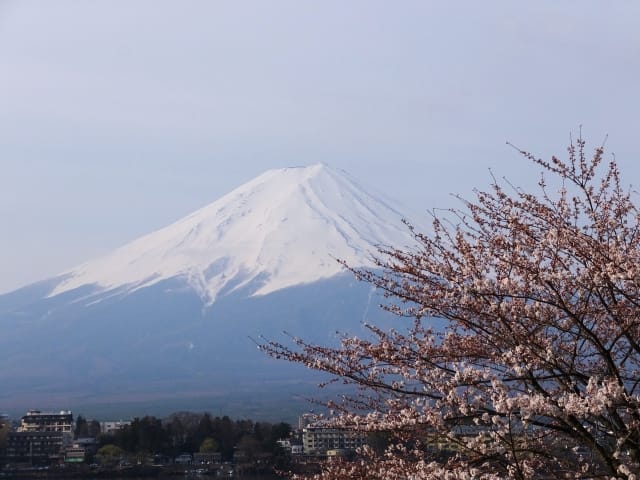
Snow begins accumulating visibly on Mt. Fuji's summit from the base typically from late September to early October each year.
Mt. Fuji climate in October shows significant changes, with the mountain's appearance transforming dramatically day by day. On days when it gets cold, heavy snowfall occurs, and the mountain can suddenly turn white in just one day. Conversely, on slightly warmer days, snow turns to rain, and accumulated snow on the mountain suddenly melts away.
In November, Mt. Fuji can be seen snow-capped on most days. When weather conditions align—including snowfall amounts and low wind—you can observe autumn's unique scenery where the boundary between snow and mountain surface forms a straight line.
Climate Feature of Spring (March, April, and May)
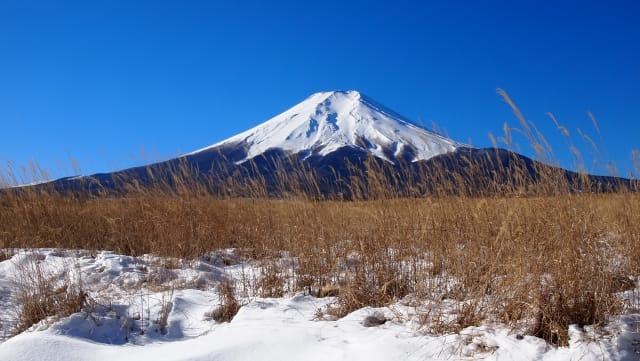
Spring Mt.Fuji often appears somewhat hazy. It is frequently covered with clouds, and this phenomenon is influenced by a complex combination of spring updrafts, pollen in the air, sand, and moisture content that characterizes the unique Mt.Fuji climate during this season.
In Japan, the white hazy Mt.Fuji has long been considered a fantastical spring sight. When viewed together with surrounding spring flowers such as cherry blossoms, plum blossoms, and rapeseed flowers, you can even more enjoy the uniquely elegant appearance that the Mt.Fuji weather creates in spring.
Until April, the upper half of Mt.Fuji is firmly covered with snow, but in May, snow melting slowly begins and the amount of snow decreases. In March, the minimum temperature can go below zero even in the foothills area. When April arrives, the daytime sunshine becomes warm and you can spend time comfortably. Until around mid-March, traditional plum blossoms bloom in the surrounding area and can be enjoyed together with Mt.Fuji.
When do the surrounding cherry blossoms start to bloom?
Around Mt.Fuji areas such as Lake Kawaguchi, cherry blossoms begin to bloom from late March. They reach their peak in mid-April, and from scenic spots in the surrounding area, you can view spring Mt.Fuji together with the brilliant cherry blossoms in full bloom. Arakura Sengen Shrine is a famous spot where you can view cherry blossoms and Mt.Fuji together.
Also, in April, yellow spring flowers - rapeseed flowers - bloom beautifully around Mt.Fuji. Mt.Fuji towering behind the yellow rapeseed flower fields has a very nostalgic and gentle atmosphere, and it's a sight I look forward to every year.
Shibazakura (moss phlox) with beautiful deep pink flowers is also famous as a spring flower in the Mt.Fuji area. The best viewing time is from late April to early May, and the "Fuji Shibazakura Festival" is also held near Lake Motosui. At the venue, you can beautifully view the shibazakura flower fields that look like pink carpets and the magnificent Mt.Fuji.
Climate Feature of Winter (December, January, and February)

Winter is a season when you can enjoy clear views of Mt.Fuji because the air is crisp. The excellent Mt.Fuji weather conditions during winter provide many sunny days, and clouds tend to be fewer than in other seasons.
The morning of a clear, sunny day in winter with crisp air is said to be the timing when Mt.Fuji looks most beautiful. The exceptional Mt.Fuji climate during winter creates perfect conditions for viewing, and on clear winter morning days, you can also beautifully see the Diamond Fuji phenomenon, where the sun overlaps with Mt.Fuji's summit and shines like a diamond.
Winter Mt.Fuji is covered with snow continuously from December to February. January has even more snow than December, and it's a season when you can enjoy the sight called "Beni Fuji" where the snow is dyed red by the evening sun.
February has the most snow of the year, and on windless days, you can also see pure white Mt.Fuji covered with snow down to the foothills. On days when snow accumulates in the foothill towns, you can see the fantastical view of the snow-white town and pure white Mt.Fuji.
For enjoying hot springs and rich nature while viewing Mt.Fuji, "Hakone" is also recommended

If you want to enjoy hot springs and rich nature while viewing Mt.Fuji, the nearby popular resort area Hakone is also recommended.
Hakone can be accessed from the Mt.Fuji area in about one hour by car. Hakone is a volcanic area and hot spring resort where high-quality hot springs abundantly spring forth. It has valleys in volcanic areas where volcanic smoke rises and beautiful lakes, and is also famous as an area where you can beautifully view Mt.Fuji.
If you use Magical Trip's private tour, you can head to Hakone from Tokyo in a dedicated car and enjoy a day trip together with a knowledgeable dedicated guide.
In this private tour's recommended plan, you visit many spots where you can view Mt.Fuji together with Hakone's unique nature. My favorite is viewing Mt.Fuji from the ropeway that you ride on the way to Owakudani where sulfur volcanic smoke rises.
Mt.Fuji seen beyond the magnificent mountains gives a different magnificent impression from viewing it from the foothills such as the Fuji Five Lakes. At the end of the day, let's relax by soaking in a foot bath while enjoying the beautiful scenic views of Mt.Fuji and Hakone.
Those who want to enjoy the beautiful appearance of Mt.Fuji should definitely consider Hakone, which has unique culture and hot springs, as a destination candidate.
・Meeting point: Pickup available at your accommodation hotel in Tokyo
・Tour area: Hakone area
・Start time: 8:00
Climate Around Mt. Fuji Explained by Season
Climate During Climbing Season (Early July - Mid-September)

The official climbing season for Mt. Fuji typically runs from early July to early September. At the summit (3,776m), the temperature is about 22-23°C lower than at the base, and snow may remain even in midsummer. For those planning to attempt the summit, check our complete guide to Mt. Fuji hiking routes and safety tips.
While recent news has highlighted snow-free periods on Mt. Fuji, possibly due to global warming, the mountain is typically only free of snow around September, at summer's end. During the climbing season, while extreme cold isn't a major concern, climbers should prepare for temperatures cold enough for snowfall.
The weather on Mt. Fuji can be quite severe, with typhoon-strength winds being common and occasional thunderstorms. It's advisable to regularly check weather forecasts (available up to two weeks in advance) and real-time weather observation sites for Mt. Fuji.
Recommended Clothing for Climbing Season (For Climbers)
For the climbing season, full professional climbing gear is recommended. While cold protection is crucial, quick-drying inner layers are essential as the challenging trails can cause heavy sweating. For detailed seasonal fashion advice, check our comprehensive Mt. Fuji clothing guide for every elevation and tourist spot.
Sturdy two-piece rainwear is necessary for sudden rain and wind. All-weather trekking shoes are recommended. Work gloves, regular gloves, towels, spare inner wear, and socks are good to have. Don't forget coins for mountain hut toilets.
Recommended Clothing for Climbing Season (For Non-Climbers)
The Mt. Fuji area often experiences sudden weather changes, with temperature variations equivalent to summer and winter within hours depending on elevation.
Even if not climbing, wear layers for easy temperature adjustment. Summer sun exposure can cause significant physical stress and fatigue. Use hats, sunglasses, parasols, and sunscreen for full protection. Avoid revealing clothes and opt for UV-protective clothing.
Related Article
・Explore Mt. Fuji in Summer: A Complete Guide for Foreign Visitors
Fuji in summer, climbing Mt. Fuji is an absolute must. However, in addition to mountain climbing, there are actually many sightseeing spots around Mt.Fuji.
Climate Before Climbing Season (Spring to Summer)

Around the Fuji Five Lakes, a popular tourist spot with Mt. Fuji views, temperatures are about 5°C lower than central Tokyo, with particularly cool mornings and evenings.
Mid-April brings the spectacular combination of Japan's two major symbols - Mt. Fuji and cherry blossoms. While days are warm with spring sunshine, temperatures drop significantly after sunset, often bringing "flower-viewing chills."
From early May's Golden Week holidays, the weather becomes consistently warmer, making foot-of-the-mountain day camping and outdoor activities pleasant. This area, traditionally loved as a summer retreat, enters its prime season.
Recommended Clothing for Pre-Climbing Season
Early spring's mountain weather brings significant temperature variations between mornings/evenings and midday, so thick cardigans or down jackets are recommended.
Even approaching summer, winds from Mt. Fuji can feel cold, so having hoodies or light outer layers is convenient.
Related Article
・Mount Fuji in Spring: Complete Guide to Cherry Blossoms, Events & Activities 2026
Discover the scenery around Mount Fuji in spring and learn about our specially recommended spots for the season. If you're planning a spring visit, this guide is a must-read!
Climate After Climbing Season (Autumn to Winter)

The Fuji Five Lakes area has a comfortable average temperature of about 18°C in September, perfect for cultural activities like museum visits around the lakes. However, this is a rainy period, so rain gear is essential.
Around October, when Mt. Fuji's first snow is observed, the surrounding area cools significantly, with average minimum temperatures dropping below 10°C.
November, peak autumn foliage season, sees average highs of 14.0°C and night temperatures below 3°C. Popular illuminated foliage spots are cold enough to require bonfires.
The cold, clear air makes this season ideal for stargazing.
Related Article
・Autumn at Mt. Fuji: A Complete Guide for Foreign Visitors
Experience the landscapes surrounding Mount Fuji in fall and explore our favorite locations for the autumn season. If you're heading there in fall, don't miss out on this essential guide!
Spring and fall stand out among Japan's four seasons for their particularly pleasant weather and stunning natural beauty. In spring, cherry blossoms bloom in magnificent displays, while in fall, the autumn foliage paints Mount Fuji in vibrant colors.
These two seasons are also known for being the best times to enjoy Japanese cuisine at its finest.
Spring and fall are the perfect seasons to join a Magical Trip tour to experience delicious Japanese food and breathtaking views of Mount Fuji. Come visit during either season and make the most of your time exploring the Mount Fuji area!
・Mt. Fuji Full-day Nature Guided Tour with a Private Chartered Car & Guide
Winter (December - March) Climate

During winter, Mt. Fuji's summit and base experience severe low temperatures with frequent snowfall. The strong seasonal winds also contribute to harsh weather conditions.
Around the Fuji Five Lakes in December, average minimum temperatures drop to -3°C. From January to February, average high temperatures are around 6°C, with average lows reaching about -5°C.
Despite facing severe winter cold, there's a silver lining - relatively frequent clear days until March. One of winter's greatest pleasures is viewing Mt. Fuji against a crisp, blue sky in the crystal-clear air.
Related Article
・A Guide to Enjoying Mt. Fuji in Winter for Foreign Tourists 2026 w/map
While the area around Mt. Fuji gets extremely cold in winter, these freezing temperatures create many breathtaking views that can only be seen during this season. If you'd like to experience the stunning scenery, such as Mt. Fuji adorned with snow or the beautiful frozen lakes, feel free to use this guide as you explore the area.
Recommended Clothing for Winter
For outdoor activities, ensure thorough warmth with thick inner wear, sweaters, and down coats.
Japanese winters are typically dry, so many people wear masks to protect their throats. It's also reassuring to prepare snow boots, scarves, earmuffs, gloves, knit caps, and pocket warmers as needed.
As with summer, there can be dramatic temperature differences between indoors and outdoors, so layering items like lightweight ensemble sweaters are useful.
Note about Mt. Fuji's Weather and Climate:
- The mountain creates its own microclimate, affecting local weather patterns
- Weather conditions can change rapidly at any time of year
- Temperature decreases approximately 0.6°C for every 100m increase in elevation
- The summit area experiences some of Japan's most extreme weather conditions
- Local weather forecasts should be checked frequently before visiting
[Seasonal] Recommended Events with Highlights
Let me introduce you to the seasonal events held around Mount Fuji.
If you're interested, be sure to check out our article that breaks down all the events for 2026 by month.
We've carefully selected and detailed traditional events, food festivals, and unique seasonal experiences that you can only enjoy at specific times of the year, along with what makes each one special.
Related Article
・Ultimate Guide to Mt. Fuji Events & Festivals 2026: Cherry Blossoms, Fireworks, and Seasonal Celebrations
Climbing Season (Early July - Mid-September)
Click here for more details:
Explore Mt. Fuji in Summer: A Complete Guide for Foreign Visitors
Mt. Fuji Mountain Opening Festival
Source: Official website
Mt. Fuji's climbing season opens annually on July 1st. To celebrate this occasion, the "Mt. Fuji Mountain Opening Eve Festival" is held on June 30th, when the weather typically becomes suitable for climbing with average temperatures around 15-20°C at the base.
This is a traditional event where active Fuji-ko members (religious groups that have worshipped Mt. Fuji since the 16th century) and local citizens participate. A parade proceeds from Kanadori Park to the starting point of the Yoshidaguchi climbing trail at Kitaguchi Hongu Fuji Sengen Shrine.
After arriving at the shrine, traditional Japanese Nagoshi Oharae ceremony (purification ritual for the first half of the year) and path-opening rituals are performed, announcing the start of Mt. Fuji's climbing season with its characteristic summer climate.
<Information> *2024 Information
Date: June 30th, 2024
Access: 1-minute walk from "Sengen Shrine Mae" bus stop via Fuji Kyuko Bus from "Mt. Fuji" Station on Fuji Sanroku Electric Railway Fujikyuko Line
Admission: Free
Website: https://fujiyoshida.net/event/147
Fuji Five Lakes Fireworks Festival
Source: Official website
Every summer from August 1st to 5th, when the weather is typically warm and clear around Mt. Fuji, fireworks festivals are held daily across the Fuji Five Lakes region against the backdrop of the sacred mountain.
The festival begins with the Hokosai at Lake Yamanaka, where fireworks are launched from four different areas: Yamanaka, Asahigaoka, Hirano, and Nagaike.
On the second day, the "Saiko Ryugu Festival" features a collaboration of floating lanterns and fireworks on Lake Saiko.
The third day's "Shinko Festival" at Lake Motosuko launches about 700 colorful fireworks. With many camping sites nearby, enjoying the fireworks while camping is recommended.
The fourth day's "Ryoko Festival" at Lake Shojiko includes not only fireworks but also concerts and other atmospheric events. The close proximity to the launch site offers an impressive viewing experience.
The finale at Lake Kawaguchi, the "Kojo Festival," is the largest among the Fuji Five Lakes events, featuring approximately 10,000 fireworks in a grand display.
<Information> *2024 Information
Dates: August 1-5, 2024
Location: Fuji Five Lakes (Lake Yamanaka, Lake Saiko, Lake Motosuko, Lake Shojiko, Lake Kawaguchi)
Admission: Free
Website: https://lake-yamanakako.com/event/10430
Related Article
・Experience the Spectacular Mt. Fuji Fireworks Festival 2026: Dates, Viewing Spots, and Travel Tips
Pre-Climbing Season (Spring-Summer)
Click here for more details:
Mount Fuji in Spring: Complete Guide to Cherry Blossoms, Events & Activities 2026
Fuji Motosuko Resort (Fuji Shibazakura Festival)
Source: Official website
The "Fuji Shibazakura Festival" is the most unmissable event at Fuji Motosuko Resort, known for its floral attractions. The mild spring weather around Mt. Fuji creates perfect conditions for viewing these flowers.
Around 500,000 moss phlox plants, the largest scale in the Kanto region, bloom across the vast grounds at the foot of Mt. Fuji. The vivid color contrast creates a beautiful spring spectacle against Mt. Fuji's still snow-capped peak.
Visitors can enjoy a breathtaking vista of pink covering the entire area. Seven varieties of moss phlox, including McDaniel Cushion and Autumn Rose, bloom magnificently, creating stunning scenery with towering Mt. Fuji in the background.
<Information> *2024 Information
Dates: April 13 - May 26, 2024 *Dates may vary depending on weather conditions
Access: Direct access from "Fuji Motosuko Resort (Fuji Shibazakura Festival Venue)" bus stop via Fuji Kyuko Bus from "Kawaguchiko" Station on Fuji Sanroku Electric Railway Fujikyuko Line
Admission: 1,000-1,200 yen
Website: https://www.kamigamojinja.jp/en/
Yoshiwara Gion Festival
Source: Wikipedia
The Yoshiwara Gion Festival is celebrated in the Yoshiwara district (Fuji City, Shizuoka Prefecture), which has long prospered as a base for Mt. Fuji pilgrimages and as a travel hub. The festival, which began in the 19th century to pray for good health, is affectionately known locally as "Otenno-san (Tenno Festival)."
Twenty-one unique festival floats (dashi - traditional pulled or carried festival displays in Japan) from six local shrines (Tenjin Shrine, Yasaka Shrine, Wada Hachimangu Shrine, Yamanokamisha Shrine, Hachimangu Shrine, and Kinomoto Shrine) parade magnificently along the approximately 1km stretch of Yoshiwara Honmachi Street and its surroundings. With Mt. Fuji's climate creating a perfect backdrop for outdoor festivities in early summer, the festival has become a cherished tradition.
Food stalls line the pedestrian-only streets, creating a lively festival atmosphere.
<Information> *2024 Information
Dates: June 8-9, 2024
Access: 5-minute walk from Yoshiwara-Honcho Station on the Fuji Gakunan Railway
Admission: Free
Website: https://yoshiwara-shoutengai.com/
Post-Climbing Season (Autumn-Winter)
Click here for more details:
Autumn at Mt. Fuji: A Complete Guide for Foreign Visitors
FUJI-Q HALLOWEEN Horror Night
Source: Official website
"FUJI-Q HALLOWEEN Horror Night" is a popular annual Halloween event held at Fuji-Q Highland. The park is famous for consistently ranking first in the "Real Haunted House Ranking."
The event offers the "ultimate" horror experience where visitors confront ghosts in the dark, quiet park after closing. Taking advantage of the cool autumn weather near Mt. Fuji, the event creates an eerily perfect atmosphere.
One unique feature is access to normally restricted backstage areas and closed attractions, offering a completely different atmosphere from the daytime amusement park.
Challenge various missions as if you're the protagonist of a horror movie. It's terrifying yet addictive - an unforgettable experience.
<Information>
Dates: October 25 (Fri) and 27 (Sun), 2024
Access: Direct access from Fuji-Q Highland Station via JR East Chuo Line and Fujisan Railway Fujikyuko Line from Otsuki Station
Fee: 3,000 yen *Requires additional admission pass (Free Pass, Afternoon Pass, or Sunset Night Pass)
Website: https://www.fujiq.jp/
Fuji Kawaguchiko Autumn Leaves Festival
Source: Official website
The "Kawaguchiko Momiji Corridor" on the northern shore is Lake Kawaguchiko's premier autumn foliage spot. The weather patterns around Mt. Fuji create ideal conditions for vibrant fall colors.
The Fuji Kawaguchiko Autumn Leaves Festival attracts many visitors during the foliage season. During the festival period, the venue area bustles with food stalls, souvenir shops, and craft markets.
The main attraction is the illuminated Momiji Corridor. From sunset to night, the brilliantly red autumn leaves are lit up, creating an even more mystical landscape.
The tunnel of illuminated maple leaves presents an otherworldly beauty. The moment near sunset when you can see both the lit-up autumn leaves and Mt. Fuji is particularly spectacular. Don't miss it!
<Information>
Dates: October 26 - November 20, 2024
Access: From Otsuki Station on JR East Chuo Line and Fujisan Railway Fujikyuko Line, take train to Kawaguchiko Station, then transfer to Kawaguchiko Loop Bus Red Line and get off at "Itchiku Kubota Art Museum." About 20-minute walk from there
Admission: Free
Website: https://kitakawaguchiko.co.jp/archives/introduce/post31
Winter (December-March Climate)
Click here for more details:
A Guide to Enjoying Mt. Fuji in Winter for Foreign Tourists 2026 w/map
Lake Yamanakako Illumination "Fantasyum"
Source: Official website
The Lake Yamanakako Illumination "Fantasyum" has become a popular winter festival.
Set against Mt. Fuji's winter climate backdrop and beneath a star-filled sky, vibrant illuminations create a mystical landscape. The creative displays include Japanese umbrellas, offering a mysterious fusion of traditional Japanese aesthetics with modern lighting technology.
Visitors can enjoy food and beverages in the park's heated greenhouse, making it perfect for an extended stay. Don't miss the spectacular winter fireworks displayed on Saturdays and New Year's Day during the event period.
<Information>
Dates: December 1, 2024 (Sun) - January 13, 2026 (Mon)
Access: 3-minute walk from "Hananomiyako Koen Iriguchi" bus stop via Fuji Kyuko Bus/Fuji Kyuko Mobility from "Kawaguchiko" Station on Fuji-san Roku Denki Railway Fujikyu Line
Admission: 350 yen
Website: http://www.hananomiyakokouen.jp/
Lake Kawaguchiko Winter Fireworks
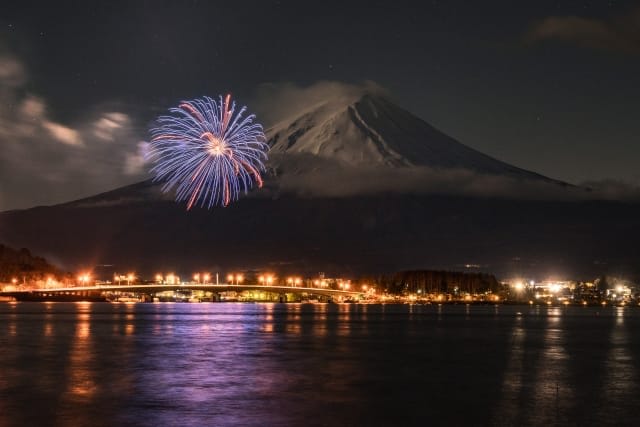
The "Lake Kawaguchiko Winter Fireworks" has become a winter highlight around Mt. Fuji.
The weather conditions unique to Mt. Fuji's winter climate create a perfect setting for these fireworks, which appear even more brilliant against the crisp, cold air than their summer counterparts. The dry winter atmosphere carries the thunderous sounds with remarkable clarity, creating an immersive experience.
On calm evenings when the lake surface is still, visitors can witness spectacular "inverse fireworks" reflected in Lake Kawaguchiko. The main launch site is at Oike Park, with additional displays from Tatami-iwa and Yagisaki Park. Don't miss the moments when fireworks are launched simultaneously from all three locations.
<Information>
Dates: Planned for 10 shows on Saturdays and Sundays from January 25 to February 23 (Mt. Fuji Day), 2026
Access: Directly accessible from "Kawaguchiko Herb Hall" stop on the Kawaguchiko Loop Bus Red Line from "Kawaguchiko" Station on Fuji-san Roku Denki Railway Fujikyu Line
Admission: Free
Website: https://fujisan.ne.jp/pages/403/
Summery
The area around Mount Fuji offers unique attractions throughout the year, making it a perfect spot to experience Japan's four seasons. Fall and spring are particularly stunning, offering spectacular views of cherry blossoms or autumn foliage against the backdrop of Mount Fuji.
However, because of these distinct seasonal changes, you'll need to prepare accordingly for each season. If you're planning to climb Mount Fuji, make sure you're thoroughly prepared and don't underestimate the challenge.
For those looking for a more casual Mount Fuji experience, consider trying Magical Trip's "Mt. Fuji Full-day Nature Guided Tour with a Private Chartered Car & Guide," which includes private car transportation from Tokyo.
Magical Trip also offers other guided tours in Tokyo and Osaka, where knowledgeable local guides who know these cities inside and out can show you around.
・Tokyo Bar Hopping Night Tour in Shinjuku
・Asakusa Cultural Walk & Matcha Making Tour
・Fushimi Inari Hidden Hiking Tour
・Osaka Bar Hopping Night Tour in Namba

